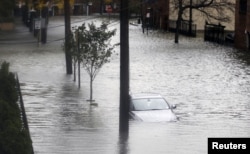GENEVA —
While Superstorm Sandy created havoc as it barreled its way across the Eastern seaboard of the United States, the World Meteorological Organization (WMO) said weather predictions and the national response to the disaster are working as they should. The deadly storm has left millions of homes without power.
The World Meteorological Organization said the weather systems it has in place performed brilliantly in forecasting Hurricane Sandy. It said the 48-hour forecast tracking the route of the storm showed how Sandy would be pushed on shore.
WMO’s Director of Weather and Disaster Risk Reduction Services, Geoff Love, said there is virtually no difference between the analysis of likely events and the forecast. He said the 48-hour forecast was spot-on.
“The environmental conditions were perfect. The forecasts were very, very, very good and, of course, we have seen on the media the U.S. emergency authorities all responded exceedingly well," said Love. "So, from the WMO perspective, it is a disaster. But, boy, all our systems worked really well - the U.S. forecast, the U.S. Emergency Management systems. And, it will be seen as, probably, a text-book case in how well you can do.”
Although the forecasting and disaster preparedness efforts are working well, Love said there is no way to minimize the consequences of this catastrophic disaster. Besides the unfortunate loss of life, he said it will take time to assess the enormous property damage and tally up the bill.
Despite this unavoidable downside, Love said WMO would like to see every country do as well in forecasting and preparing for predicted disasters. On the basis of a 48-hour forecast for Thursday, he said Sandy remains a powerful and dangerous storm.
“It is still a very big system. It will probably still be bringing substantial rain to the East Coast. Snow up north in Canada," said Love. "It is still a big, slow moving weather system and probably has not finished yet, and that will make recovery trickier than normal.”
Sandy continues to move inland over the northeastern United States.
Last week, Sandy did not directly hit the poor Caribbean island of Haiti. But heavy winds and heavy rainfall from the storm caused extensive damage. Official figures put the number of confirmed deaths at 29, with eight wounded and four people missing.
The United Nations reports almost 6,000 families are affected, thousands of houses flooded, destroyed and damaged and nearly 19,000 people were evacuated to 136 emergency shelters.
Haiti is still suffering from the catastrophic 2010 earthquake, which affected three million people, killing more than 316,000. U.N. officials said Haiti will need a lot of help to recover from this latest disaster.
The World Meteorological Organization said the weather systems it has in place performed brilliantly in forecasting Hurricane Sandy. It said the 48-hour forecast tracking the route of the storm showed how Sandy would be pushed on shore.
WMO’s Director of Weather and Disaster Risk Reduction Services, Geoff Love, said there is virtually no difference between the analysis of likely events and the forecast. He said the 48-hour forecast was spot-on.
“The environmental conditions were perfect. The forecasts were very, very, very good and, of course, we have seen on the media the U.S. emergency authorities all responded exceedingly well," said Love. "So, from the WMO perspective, it is a disaster. But, boy, all our systems worked really well - the U.S. forecast, the U.S. Emergency Management systems. And, it will be seen as, probably, a text-book case in how well you can do.”
Although the forecasting and disaster preparedness efforts are working well, Love said there is no way to minimize the consequences of this catastrophic disaster. Besides the unfortunate loss of life, he said it will take time to assess the enormous property damage and tally up the bill.
Despite this unavoidable downside, Love said WMO would like to see every country do as well in forecasting and preparing for predicted disasters. On the basis of a 48-hour forecast for Thursday, he said Sandy remains a powerful and dangerous storm.
“It is still a very big system. It will probably still be bringing substantial rain to the East Coast. Snow up north in Canada," said Love. "It is still a big, slow moving weather system and probably has not finished yet, and that will make recovery trickier than normal.”
Sandy continues to move inland over the northeastern United States.
Last week, Sandy did not directly hit the poor Caribbean island of Haiti. But heavy winds and heavy rainfall from the storm caused extensive damage. Official figures put the number of confirmed deaths at 29, with eight wounded and four people missing.
The United Nations reports almost 6,000 families are affected, thousands of houses flooded, destroyed and damaged and nearly 19,000 people were evacuated to 136 emergency shelters.
Haiti is still suffering from the catastrophic 2010 earthquake, which affected three million people, killing more than 316,000. U.N. officials said Haiti will need a lot of help to recover from this latest disaster.









